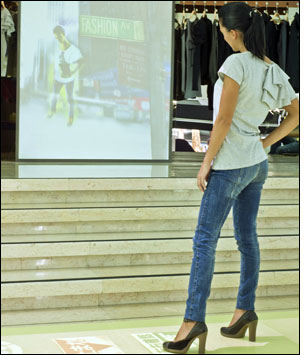Oct 22, 2010When customers shop at Fly London, an upscale shoe and accessory store on Avenida da Liberdade, in Lisbon, Portugal, they can do more than just try on a pair of shoes. Here, thanks to radio frequency identification, a patron can place a pair of shoes on her feet and look at her own image taken from a camera aimed in her direction. The image, however, will not show her standing in the store itself, but rather in front of busy street scenes in Tokyo, London or New York, depending on the line of shoe she's trying on.
The goal is to have fun while shopping, says Ana Gomes, the general manager of clothing brands Foreva and Fly London, which are owned by Portuguese footwear company Kyaia. Shopping at Fly London's Lisbon store, she explains, "is not anymore about (simply) purchasing, but is transformed into a special experience that is fun to our customers."

But although the interactive floor may be the most eye-catching feature of the store's RFID deployment, Gomes says, the system's primary function lies in supply chain management—ensuring that the store's management knows, at any particular time, what is in stock, what is in the store front and what needs to be reordered by Fly London based on what the RFID data indicates has been sold. The entire solution, developed and installed by Creativesystems, is part of a project known as Shoe ID, led by Creativesystems, with participation from research and development college Instituto de Engenharia de Sistemas e Computadores do Porto (INESC Porto), which assisted with designing optimization algorithms in the software that could be used by shoe stores and manufacturers for supply chain and production-scheduling applications. The project is intended to determine whether RFID can be deployed in the footwear industry from the point of manufacture to the point of sale. "The idea of Shoe ID is to give new energy to the Portuguese footwear industry," says João Vilaça, Creativesystems' managing director.
Initially, the system enables Fly London to track inventory, including when products leave the manufacturing site and arrive at the 60-square-meter (646-square-foot) store, whether they have put out on the sales floor, and when they are sold.
The shoes sold by the store are made at a Portuguese factory operated by Kyaia. Once a pair of shoes is manufactured, factory workers attach a paper hangtag to one of the shoes containing an Avery Dennison EPC Gen 2 passive ultrahigh-frequency (UHF) RFID inlay, with a unique ID number linked in the Creativesystems software platform (known as CS.Retail) to information regarding the product's stock-keeping unit (SKU), style and size. All shoes destined for the Lisbon store are being tagged.
As product is shipped from the manufacturer and then received by Fly London, employees at the store employ handheld ATID RFID readers (according to Vilaça, the system can work with readers from other vendors as well) to capture the shoe tag's unique ID number, directly through the closed shoebox. Those handhelds use a Wi-Fi connection to forward that ID to the CS.Retail software, indicating what has been received—thereby maintaining an inventory record of the product available at the store. The software is integrated with Fly London's enterprise resource planning (ERP) system, in which inventory tracking and orders are managed.
The store includes an interactive floor measuring 6 meters by 2 meters (19.7 feet by 6.6 feet), which has an Alien ALR9900+ RFID reader and antenna built into it. The floor was developed by Surfaceslab, a company launched by Creativesystems and Vicaima, an RFID-enabled manufacturer of doors (see Portuguese Manufacturer Opens Doors With RFID).
When a customer, standing on the interactive floor, dons a tagged shoe, as soon as the shoe comes within contact with the floor, the antenna captures the unique ID number of that particular shoe's tag. The antenna sends that information via a cabled connection to the store's back-end system, where the CS.Retail software receives the ID number, and the software then determines in which of three categories the shoes fall, based on their style —London, New York or Tokyo. The software instructs the video system, built into the interactive floor and wired to a camera and flat screen, to project a streetscape of the appropriate city, along with a live image of the consumer wearing the shoe displayed on that photo.
At the point of sale, staff members access the CS.Retail software to indicate that the product linked to the tag's ID has been purchased. Creativesystems also installed a fixed Alien reader at the doorway, to allow the tags to be used as part of an electronic article surveillance (EAS) system, issuing an alert if shoes that have not been purchased are carried out the door. If the ID of the tag being taken through the door has been listed as sold in the software, an alert is not sounded.
The system was installed with the opening of the Fly London store on Sept. 1 of this year.
To date, approximately 2,000 pairs of shoes have been tagged. "For the moment, externally, we are getting great customer feedback from the fun they have," Gomes says. "Internally, we manage the store in a much more efficient and fast way, being able to do an inventory many times faster, and control all internal stock transfers, without complexity."
In the future, if the Fly London system continues to appear successful, the goal of the Shoe ID project's developers is to deploy a similar RFID system at other Portuguese shoe stores, manufacturing sites and distribution centers.


